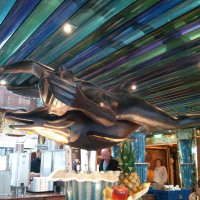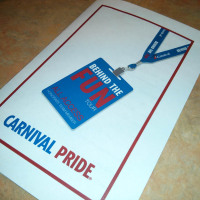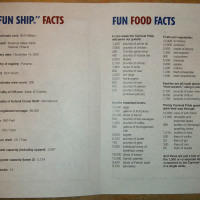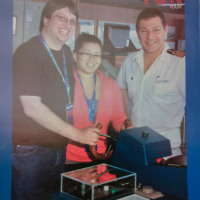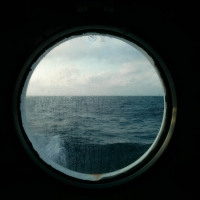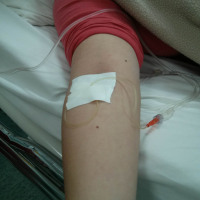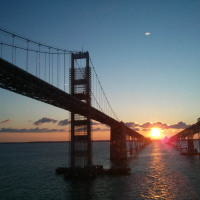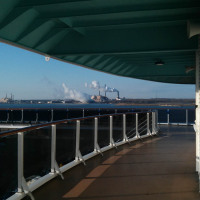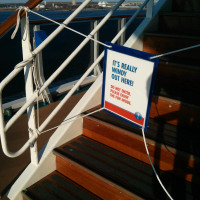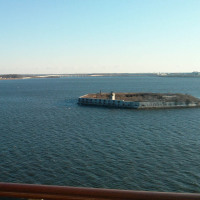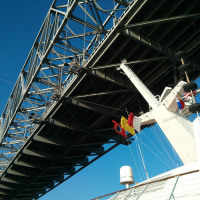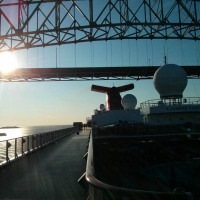We woke up early on Saturday, the last full day of our cruise. Unfortunately, Melissa wasn’t feeling very well and seemed to be running a bit of a fever. She told me that she thought she might be getting another kidney infection, like the one that she had about a year ago. We didn’t have any time to do much about it, except to get a good breakfast and drink some juice.
We gathered in the ship-board piano bar just before 9:00 a.m. for our last ‘excursion,’ which wasn’t really an excursion since it took place on the ship. Carnival has begun offering a ‘Behind the Fun’ tour, which takes you to parts of the ship that usually aren’t open to guests.
Behind the Fun
Unfortunately, cameras and cell phones were prohibited on the ‘Behind the Fun’ tour. Supposedly this is for security reasons, but nothing I saw seemed particularly secret to me. After all, if something is really a secret, it wouldn’t be the subject of a tour.
So our tour started with a metal detector to ensure that none of us had any recording devices. There were two tours, each with only sixteen people. The size of each tour was limited, since some of the places we went were pretty tight.
We started with a back-stage tour of the theater, where we met the head technician and the leader of the dance troupe. From there we proceeded to the photo processing facility, which handles thousands and thousands of photos every day, and then to the main galley where food is prepared for the dining room. It is located directly beneath the dining room, receives orders by computer, and delivers food by elevator.
From there we went down to the A deck, which is the uppermost of four crew-only decks (and the only one above the waterline). There is a main hallway on the deck, which is affectionately known as ‘I-95’ and runs the full length of the ship. The deck includes the crew mess and galley, an officer’s mess, and the captain’s mess. It also has the shipboard recycling facilities, cargo facilities, food storage, and more. The central cargo room was really fascinating, and comes complete with four on-board forklifts.
One of the highlights was the engine control room on A deck, which is the main engineering control room. The duty officers there have responsibility for the engines, bilge pumps, water systems, and more.
Here we learned that the Carnival Pride uses a particularly modern engine system. The two main engines are electric engines located on a sort of rotatable rudder/engine pod along with the props. These pods, called Azipods, can rotate a full 360 degrees, which allows them to be used as thrusters for side-to-side movement in ports (along with dedicated thrusters near the front of the ship), or even for reversing the ship without reversing the propeller rotation.
The electricity for these engines comes from six diesel generators, which also provide electricity for the rest of the ship. The power generators are not directly connected to the engines; there’s no drive shaft. There’s also no standalone rudder (although the engine pod has rudder-like qualities and could be used for steering even if the engines were dead). It’s almost like an outboard motor on a small boat, where you steer the boat by turning the entire motor . . . just take that concept and make it hundreds of times larger.
The diesel generators connected indirectly to electric motors reminded me of the Chevrolet Volt’s gasoline range extender, which, in normal driving, is just making electricity for the electric motor to use and isn’t directly connected to the drivetrain.
From there we went to a nice crew lounge and bar and got to see photos of a crew cabin (unfortunately there were no cabins available for us to actually look at in person). For the crew, they usually live two-per-cabin, and two cabins (and thus, four crewmen) share a bathroom. As a general rule men bunk together and women bunk together, although there are exceptions for married couples who share a cabin if they are both serving on the same ship. Most crewmen serve on a six- or nine-month contract. Some will do one ‘tour’ and leave, while others stay with the line for years, or even decades.
From there we went up eight decks to visit the bridge, which has, by far, the best view in the entire ship. Of course we weren’t allowed to get in anybody’s way, nor were we permitted to touch any of the consoles, but we did get to see how the ship’s controls are set up.
There are actually three control consoles, one in the center (for normal operations) and one on each side of the bridge (for use during docking and departure). The ones on the sides are actually extended out from the sides of the ship . . . so looking back from those positions you can see the entire side of the ship and position it precisely. There is also a window located in the floor, so you can look straight down to the ocean.
After our guide gave us a basic run-down of ship operations on the bridge, the captain came over and chatted with us personally and answered our questions. He also demonstrated some modern navigational aids—like a computer screen that displays the ship’s position, planned course, and those of other nearby ships all overlaid on a navigational chart. He pointed out a nearby container ship that was passing about three miles to the port side, and pulled up its information—current position, speed, course, and planned destination. Ships also now have a sort of ‘texting’ system, whereby they can send messages to one another without needing to make direct radio contact.
That was about it. We got some photos with the captain, and went back to one of the restaurant areas for some drinks and to fill out our comment forms (and get some ‘Behind the Fun’ swag). I had two recommendations for improving the tour: First, allow us to bring cameras! If there are any real security risks, prohibit the taking of photos in those particular places, not on the entire tour. Second, I would have liked to get a close-up look at one of the lifeboats. Bringing down one of the lifeboats and letting us board it for a few minutes would have been a neat addition to the tour.
All in all, it was a lot of fun.
The Infirmary
Having visited the crew facilities, engine control room, and bridge on a cruise ship for the first time, Melissa’s illness—which had not improved since the morning—led us to visit something else on-board for our first time ever: the infirmary.
Also located on A deck, although in a small publicly-accessible part of it, the infirmary is the ship-board medical facility which has at least one doctor and one nurse on staff. It serves both guests and crew, and has separate entrances for both.
After an exam, the doctor confirmed Melissa’s suspicion that she was suffering some sort of kidney and/or bladder infection and that a round of antibiotics was called for. They hooked her up to an IV and gave her a first dose of antibiotics, along with a pain killer to reduce the fever and discomfort, and then sent us on our way with drugs in-hand for her to take over the next week or so.
Of course, the doctor on-board doesn’t take any insurance and charges his services (and any drugs you need) to your shipboard account . . . so that was an additional cruise expense that we didn’t expect. But you get a full itemized receipt that you can submit to your insurance company and possibly get partially reimbursed. We’ll see how that works out.
Disembarkation
On Sunday morning, we pulled into Baltimore harbor and the cruise was over. I also started having a bit of a cough, and as we disembarked I started having some muscle aches . . . the unmistakable signs of an oncoming illness.
By the time we made it home, I was running a one-hundred degree fever and feeling down-right awful. I pretty much went straight to bed, along with Melissa who was still feeling pretty bad too. I’m glad this held-off until the cruise was over, but this is my third illness in the last three months! Ugh!

